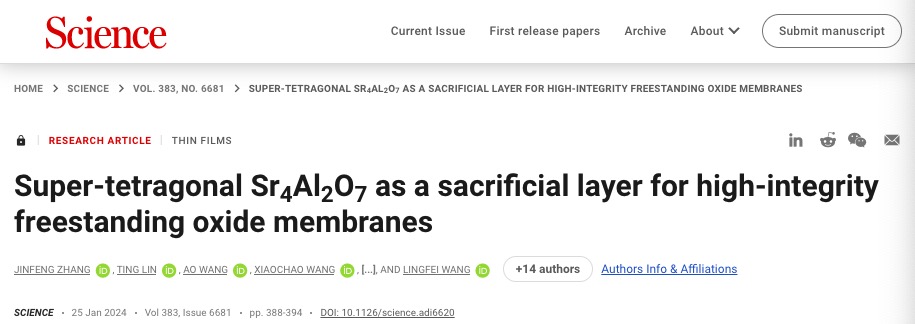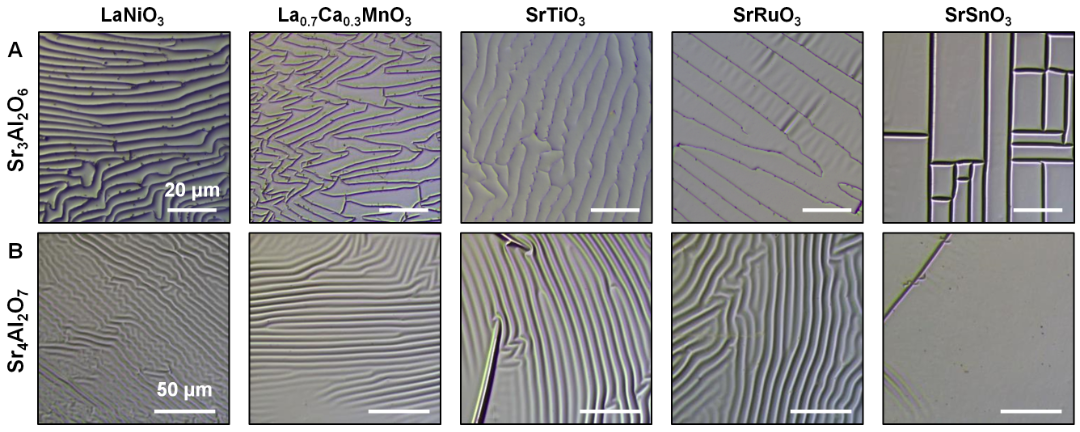Recently, Prof. Si Liang's team in the School of Physics of NWU, in collaboration with Prof. Wu Wenbin and Prof. Wang Lingfei's team in the National Research Center for Microscale Matter Science of the University of Science and Technology of China (USTC) in Hefei, China, discovered a broad-spectrum and highly efficient new type of super-tetragonal water-soluble sacrificial layer material, Sr4Al2O7, which is a high-performance oxide material for preparing a variety of high-quality self-supporting oxide thin films. The results, titled Super-tetragonal Sr4Al2O7as a sacrificial layer for high-integrity freestanding oxide membranes, were published on January 26 as a Research Article in Science. Prof. Si Liang, Prof. Wu Wenbin and Prof. Wang Lingfei are the co-corresponding authors of this paper.
Jinfeng Zhang (Ph.D. student) and Ao Wang (M.S. student) from the National Research Center for Microscale Materials Science, University of Science and Technology of China, Hefei, China; Ting Lin (M.S. student) from the Institute of Physics, Chinese Academy of Sciences; and Xiaochao Wang (M.S. student) from the School of Physics, Northwest University, China, are the co-first authors of this paper. Prof. Siliang’s research team undertook the first-principles calculations and material simulations in this project, and made key contributions to the finalization of the novel crystal structure of Sr4Al2O7 and the understanding of its structural evolution in epitaxial strain.
Self-supported oxide thin films are low-dimensional quantum materials that retain their single-crystal properties after removing the substrate, and combine the multi-degree-of-freedom coupling properties of strongly correlated electronic systems with the structural flexibility of two-dimensional materials. These materials have novel physical and material properties such as superelasticity, flexural electrical properties, and significant magnetoelastic effect, and thus help to induce novel quantum-derived phenomena and functional properties that are not found in conventional epitaxial oxide films. At the same time, due to get rid of the rigidity of the single crystal substrate, self-supported oxide films are easy to realize the integration with silicon-based semiconductors, two-dimensional van der Waals materials, and flexible polymer materials, and show great potential for application in the development of ultrathin and flexible electronic devices, which is a research hotspot in the field of condensed matter as well as oxides in recent years.
The discovery of a novel water-soluble sacrificial layer, Sr4Al2O7, provides a fast and efficient universal experimental solution for the preparation of highly crystalline, large-area self-supported oxide films. This discovery breaks through the bottleneck of self-supported oxide films in terms of integrity and crystallinity, and injects a new impetus for the development of this field, which is expected to promote the further discovery of novel quantum states in self-supported oxide films, and also enhance the application potential of this system in low-dimensional flexible electronics devices.
This research has been supported by grants from the National Key Research and Development Program of China, the National Natural Science Foundation of China, the Stable Support Program for Young Teams in Basic Research Areas of the Chinese Academy of Sciences, and the High-level Talent Program of Shaanxi Province.
Article Link:https://www.science.org/doi/10.1126/science.adi6620



